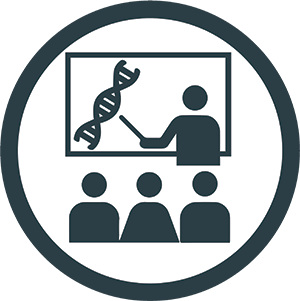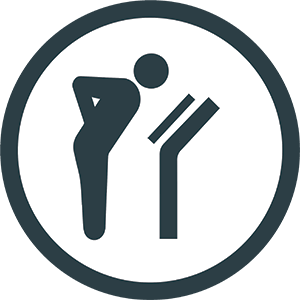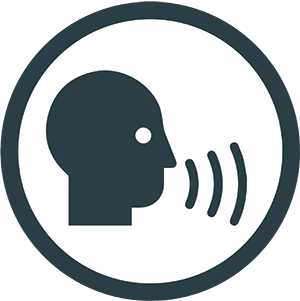Target Audiences
One of the most important things to consider is the needs of the audience you are engaging. Understanding the audiences' needs and motivations for working with you will not only make a more compelling case (rationale) for funding your BI project, it will make for a positive connection and experience when funded.
This video reviews some of the characteristics of target audiences and how you might think about the contact time and audience size when choosing a project.
There are many ways to gain insight into audience need. Listed below are descriptions of segments of society that researchers commonly engage with their BI efforts. These descriptions are dynamically linked to some key literature and background papers that will help you understand your target audience and write your rationale for your BI project. The list is not exhaustive, rather it is a sampling of potential audiences that can be used as inspiration.
Choose one that you will enjoy working with, and/or that you have an existing connection to, and/or that has some special meaning to you. For example, if you were a first-generation college student and it would be meaningful for you to identify and work with high school students who have the potential to be first-gen college students, themselves, that would be a great choice for you. Whichever audience you chose, do so with the intention of establishing a mutually beneficial relationship — one that will have value and meaning to all parties involved.
Typical Audiences for Broader Impacts
Select the audiences below that you're interested in working with. Additional guidance and selected literature references are available for each one.

Government/Policy Makers
Who will you work with?
This audience is defined as policy makers at both the local and national level, including congressmen/persons, senators, environmental managers, and political affiliates (staffers) who create ideas and plans to be carried out by government for the benefit of society.
Why is it of value to work with them?
- Demonstrate the linkage between scientific discovery and societal benefit
- Develop applications of research outcomes that improve public policy
- Integrate research into broader programs and activities of local and national interest
- Provide information to support policy formulation by Federal, State or local agencies
How will you engage them? (strategies and locations)
- Collaborate with government scientists or engineers on a research project based upon societal or environmental issues
- Provide government scientists access to and training on your research equipment
- Offer to act as an "expert" to proofread government documents or respond to requests for interviews and information
- Provide a lecture, field trip or demonstration to federal, state and local level officials
- Participate in listening feedback loops with public officials, non-profits or other partners to create solutions to societal problems

Higher Education
Who will you work with?
This audience includes undergraduate and graduate students and professors from universities, academies, 2- and 4-year colleges, seminaries, and institutes of technology.
Why is it of value to work with them?
- Enhance the future workforce
- Increase the ability to solve future challenges (i.e. energy, health, environment, and national security)
- Increase America's global competitiveness
How will you engage them?
Below are a sampling of inspirational ideas for working within higher education:
- Participate in conferences, workshops, and field activities or event planning where diversity is a priority
- Mentor graduate and post-doctoral researchers in science communication and public engagement activities
- Run a professional development workshop for professors on the methods, tools, or background of your proposed work
- Offer a course/seminar on the methods, tools, or background of your proposed work
- Partner with a K-12 educator, curriculum supervisor, or learning science researcher to review your course syllabus and work together to identify ways to interject inquiry-based teaching techniques into your college level course
- Work on inquiry based educational materials (curricula or lessons) based upon the current learning science research
- Work with a writer and/or photographer in lab or field work to develop science communication projects/products
- Write a science column for your institution's newspaper or do radio interviews with your institution's radio station
- Work with a graphic designer to create an info-graphic or data visualization product that explains your research
- Collaborate with a community college professor in your research or teaching
- Arrange novel events at your lab or facility for community colleges, primarily undergraduate institutions, or minority serving institutions
- Organize novel ways for undergraduate students to participate in meetings and activities of professional societies
- Participate in mentorship programs that provide undergraduate students the opportunity to work in your lab or in the field

Industry
Who will you work with?
This audience is described as those individuals or groups who work outside of academic institutions or government agencies, including private companies.
Why is it of value to work with them?
- Identify and establish collaborations among U.S. academic institutions, industry and government; and with international partners
- Facilitate academic (tech-transfer) advancements into the commercial sector
- Stimulate and support the development and dissemination of next-generation instrumentation, multi-user facilities, and shared research and education platforms
- Maintain, operate, and modernize facilities and science and technology centers and engineering research centers
How will you engage them?
- Collaborate with industry scientists on a research project
- Provide training and access to industry scientists for your research equipment
- Explore opportunities with the NSF Industrial Innovation and Partnership Program
- Support a non-academic research internship with industry (see Partners to Accelerate Technological Development program) such as the NSF INTERN program
- Explore options for developing or partnering with an NSF Industry-University Cooperative Research Center
- Participate in an Industry led public event such as the Siemens STEM Day.

K-12 Aged Children
Who will you work with?
This audience includes young people participating in formal learning settings, from grades Kindergarten to High School, or informal learning or Out of School time (OST) learning including after-school, summer programs, 4-H, Y.M.C.A, Boys and Girls Clubs, Boy and Girl Scouts, etc.
Why is it of value to work with them?
- Foster a scientifically literate population
- Enhance the future workforce
- Increase the ability to solve future challenges (i.e. energy, health, environment, and national security)
- Increase America's global competitiveness
How will you engage them?
- Work with a school to organize a family science night
- Work with a school to develop an after-school club/program
- Work with your local youth organization (e.g. 4-H, Boy Scouts, or Girl Scouts) to develop a project related to your research
- Participate in high school mentorship programs that provide students the opportunity to work in your lab or in the field
- Attend a career day at an elementary, middle or high school
- Become a "Scientist in Residence" in a school, mentoring students for a year or semester
- Spend a week intensively working with a class on a inquiry-based project
- Work on research-based educational materials (curricula or lessons) focusing on your topic
- Work with a homeschool group/society on a project
- Host "Live From" calls or video chats from your lab or research cruises
- Hire a computer science graduate student or graphic designer to create data visualization products that highlight your current research
- Work with media producers (video and/or radio) to develop a product on your topic
- Work with a journalist or consultant to develop a children's book or music CD focusing on your research
- Collaborate with a professional writer and/or photographer to accompany you in lab or field work and post the information on a website for students to follow along
- Assist in leading a field trip for visiting students
- Work with museum staff in designing research-based educational materials (curricula or lessons) focusing on your topic to be used during class visits
- Work with museum staff on school programs, where classes come to the museum to study a particular topic using a combination of exhibits and in-laboratory experiences
- Participate in mentorship programs that provide high school students the opportunity to work in your lab or in the field

Educators (K-12 and Informal)
Who will you work with?
This audience includes educators from formal settings (public or private schools) or informal settings (Out of School Time (OST), after-school, summer programs, 4-H, Y.M.C.A, Boys and Girls Clubs, Boy Scouts, Girl Scouts, etc).
Why is it of value to work with them?
- Foster a scientifically literate population
- Enhance the future workforce
- Increase the ability to solve future challenges (i.e. energy, health, environment, and national security)
- Increase America's global competitiveness
How will you engage them?
- Assist in leading a field trip or laboratory demonstration for a teacher workshop
- Become a guest lecturer in a sponsored workshop or webinar
- Hire a computer science graduate student or graphic designer to create data visualization products that highlight your current research
- Work on on- or offline research-based educational materials (curricula or lessons)
- Offer to work with your School of Education to be a guest lecturer for an existing science methods course for pre-service teachers
- Partner with a community college faculty person to develop a "science methods" course for pre-service teaching students
- Work with your School of Education to organize a science workshop where you demonstrate your research and equipment to pre-service teaching students
- Have a teacher join you on a cruise or work in your lab
- Work with faculty from your School of Education to develop an internship in your laboratory for a pre-service teacher
- Hire a professional writer and/or photographer to accompany you in lab or field work and post the information on a website for teachers to use with their class
- Work with an educational non-profit to design lesson plans for after school clubs or summer camp courses around you research
- Work with a school to develop an after-school club/program focusing on science and your area of interest

Life Long Learners
Who will you work with?
This audience includes people of all ages who are interested in science and may or may not be well informed about science or scientific activities.
Why is it of value to work with them?
- Improve the public perception of science for voting purposes
- Improve decision making skills of the public
- Foster a scientifically literate population
How will you engage them?
- Organize a BioBlitz to monitor the species in your local ecosystem
- Act as a "scientist in residence" for local organizations and clubs
- Give a lecture for local environmental or social organizations or to interested public at libraries, town halls, Road Scholar, etc.
- Organize an open house of your laboratory or research facility
- Hire a professional writer and/or photographer to accompany you in lab or field work and post the information on a website
- Write a press release highlighting your research or invite a reporter to go out in the field with you or participate in laboratory activities
- Contact your University Relations Office to offer to be on their "expert list" to respond to newspaper, radio, and TV requests for interviews and information
- Work with a media specialist to produce a podcast, slideshow, or video on your work
- Work with museum staff to design floor activities (quick activities run on the floor of the museum)
- Work with museum staff in designing research-based educational materials (curricula or lessons)

Public
Reflect on their unique identities (e.g., research interests, hobbies, personal characteristics) and locate community groups outside academia that their identities may resonate with (prison, religious, hobbyist communities, community programs, etc)
Who will you work with?
This audience includes communities not normally addressed with BI efforts. Develop programs that bring science and scientists to people who do not or cannot gain access to science in traditional science educational venues. Participants should strive to learn from each other.
Why is it of value to work with them?
- Inclusion of often forgotten potential audiences
- Increase science literacy
How will you engage them?
- Engage a specific hobbyist group with an activity (lecture, bird count)
- Develop an Electronic Field Guide app
- Work with newspapers/magazines on material based upon your topic
- Create outreach program for a local prison
- Work with existing networks, agencies or facilities
- Develop a cultural sensitivity program to introduce other scientists to working with non-traditional audiences striving for mutual exchange of knowledge
- Develop program with a local professional sports team to highlight the STEM in sports